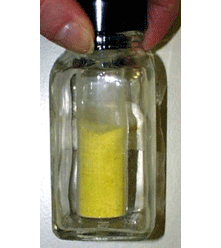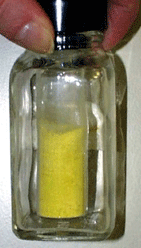Recycling Nuclear Waste
Air Date: Week of March 10, 2006

High purity uranium oxide product recovered from spent nuclear fuel (Photo: Department of Energy)
The Bush administration wants to reverse a 30-year policy against reprocessing nuclear waste. The costly process was banned because it produces plutonium, which could be used to make weapons. But the government says new technology could make this "recycling" safe. Living on Earth’s Jeff Young reports.
Transcript
GELLERMAN: From the Jennifer and Ted Stanley studios in Somerville, Massachusetts, this is Living on Earth. I’m Bruce Gellerman, sitting in for Steve Curwood.
For 30 years, U.S. government policy has banned the reprocessing of nuclear waste. Presidents since Gerald Ford have concluded that reprocessing was too costly and too risky – it creates weapons-grade plutonium that could fall into the hands of terrorists or rogue states.
Now the Bush administration wants to reverse that policy with something called the Global Nuclear Energy Partnership. It’s a multi-billion dollar research effort aimed at recycling spent fuel not just from reactors in the U.S., but in the future from developing countries as well.
Living on Earth’s Jeff Young reports from Washington.
YOUNG: Recycling your trash is a good idea, right? So Deputy Secretary of Energy Clay Sell asks, why not recycle our nuclear waste?
SELL: All leading thinkers that have looked at nuclear power, that have looked at how we can accomplish our goals for clean development, recognize that that will eventually lead us to recycling of spent fuel.

High purity uranium oxide product recovered from spent nuclear fuel (Photo: Department of Energy)
SELL: It allows you to extract much greater energy out of the spent fuel, and it also results in a waste form at the end of the process that is much more stable and much easier to dispose of.
YOUNG: The proposal also aims for greater international control of the movement of nuclear materials. If a developing country wanted nuclear power, it could lease fuel from the US, France or Britain, then return the waste for reprocessing.
SELL: If a country has the ability to enrich uranium, or to reprocess plutonium, it effectively has the bomb.
YOUNG: So that’s Sell’s sales pitch: slow the spread of nuclear weapons materials, get more energy from fuel, and reduce waste. His first audience on Capitol Hill was receptive. New Mexico Republican Senator, Pete Domenici , is a fan of nuclear power and reprocessing.
DOMENICI: In the 70s the US decided to abandon its leadership on nuclear recycling and let the rest of the world pass us by. With the creation of this new global nuclear energy program we’re going to get back into the ballgame.
YOUNG: South Carolina Republican Senator Lindsey Graham called the program “visionary.” But the reprocessing idea is getting a frosty reception elsewhere.
LYMAN: Well of course it sounds good, the slogan that we should be recycling our nuclear waste instead of throwing it away is appealing on the surface. But the problem is once you start looking at the details, the program completely falls apart.
YOUNG: That’s Ed Lyman of the advocacy group Union of Concerned Scientists. Lyman says materials produced by the technology DOE is pushing could still be used to make weapons. And he’s skeptical of claims that reprocessing would solve the waste problem.
LYMAN: Unfortunately reprocessing doesn’t actually reduce radioactive waste. All it does is shuffle it around. The fact is all these materials have to be disposed of somewhere.
YOUNG: Some scientists who support the administration’s general ideas are still uneasy with the proposal. Ernie Moniz teaches physics at MIT and served the Clinton administration as a science advisor and undersecretary of energy. Moniz says reprocessing technology is not ready.
MONIZ: It may lead us down the wrong technology pathway. So again, rushing into large-scale reprocessing would seem to be a bit premature until one has technologies for the whole integrated system in hand.
YOUNG: And then there’s the price tag. The administration wants $250 million for the Nuclear Energy Partnership next year. But that’s just a down payment on a program that Energy Secretary Sam Bodman says could cost tens of billions of dollars.
BODMAN: This is going to be a very expensive undertaking if we decide to go forward with it. My own estimate, personal estimate, is that it’s gonna be between $20 and $40 billion to accomplish all this.
YOUNG: England, France, Japan, and Russia all reprocess spent nuclear fuel with mixed results. There’s less waste, but the countries still have some 240 tons of plutonium to store and guard. But that does not deter the DOE’s Sell, who says new technology would make a US-led program different.
SELL: A program based on the old reprocessing technology cannot and should not survive. But we believe that there is a better way.
YOUNG: As it considers the President’s budget Congress must decide if it agrees that this “better way” is worth billions and the reversal of long-standing policy. For Living on Earth, I’m Jeff Young in Washington.
Links
"Extracting Plutonium from Nuclear Reactor Spent Fuel"
"Hearings Demonstrate Little Enthusiasm for Nuclear Fuel Reprocessing"
Living on Earth wants to hear from you!
Living on Earth
62 Calef Highway, Suite 212
Lee, NH 03861
Telephone: 617-287-4121
E-mail: comments@loe.org
Newsletter [Click here]
Donate to Living on Earth!
Living on Earth is an independent media program and relies entirely on contributions from listeners and institutions supporting public service. Please donate now to preserve an independent environmental voice.
NewsletterLiving on Earth offers a weekly delivery of the show's rundown to your mailbox. Sign up for our newsletter today!
 Sailors For The Sea: Be the change you want to sea.
Sailors For The Sea: Be the change you want to sea.
 The Grantham Foundation for the Protection of the Environment: Committed to protecting and improving the health of the global environment.
The Grantham Foundation for the Protection of the Environment: Committed to protecting and improving the health of the global environment.
 Contribute to Living on Earth and receive, as our gift to you, an archival print of one of Mark Seth Lender's extraordinary wildlife photographs. Follow the link to see Mark's current collection of photographs.
Contribute to Living on Earth and receive, as our gift to you, an archival print of one of Mark Seth Lender's extraordinary wildlife photographs. Follow the link to see Mark's current collection of photographs.
 Buy a signed copy of Mark Seth Lender's book Smeagull the Seagull & support Living on Earth
Buy a signed copy of Mark Seth Lender's book Smeagull the Seagull & support Living on Earth

